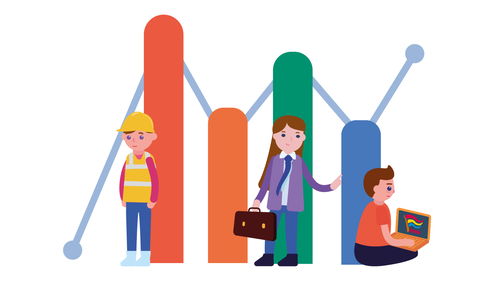On November 20th, 2024, the Central Statistics Office (CSO) published the Labour Force Survey (LFS) for Quarter 3 2024, which covers the months July to September. In this quarter 129,500 people were unemployed, a decrease of 400 people over the year. The unemployment rate in Q3 2024 was 4.5%, a decrease of 0.1 percentage point (ppt) over the year. The unemployment rate for women was 4.7%, 0.1 ppt higher than the same quarter in 2023. The unemployment rate for men was 4.2%, 0.3 ppt lower than Quarter 3 2023. Women accounted for 50.2% of the unemployed in Q3 2024, 3.2 percentage points higher than in Quarter 3 2023.
The unemployment rate for young people aged 15-24 years was 11.5%, a decrease of 0.8 percentage points over the year. The unemployment rate for people aged 25-74 years olds was 3.4%, the same as Quarter 3 2023. Young people accounted for 35% of the unemployed in Quarter 3 2024, a slight decrease over the year.
The number of people deemed long-term unemployed decreased by 13% over the year to 27,100 people. The long-term unemployment rate fell by 0.2 percentage point to 0.9, the second quarter in a row it has been under 1%. Women accounted for 52% of the long-term unemployed in Q3 2024, 12 percentage points higher than in Quarter 3 2023.
The Potential Additional Labour Force (PALF) captures people who may not fit into the official definition of unemployment, whereby people have to be actively seeking work for the previous four weeks and available to take up work in the coming two weeks of the survey. In Q3 2024, PALF stood at 129,400, an increase of 41% or 37,800 people on Q3 2023. The CSO noted that “Of those who stated that they wanted to work but were not seeking work or available for work in Q3 2024, 22.1% said this was due to education or training. This compares to 17.5% a year earlier and 13.7% in Q3 2022. Persons not seeking work due to own illness or disability accounted for 32.8% of the total in Q3 2024, down from 37.1% in Q3 2023 and down from 39.2% in Q3 2022.”
Over the year the number of people employed in Ireland increased by 3.7% to 2,794,800 people. Full-time employment increased by 4.5% to 2,209,100 people, accounting for 79% of those in employment. The employment rate was 75.3%, an increase of 0.1 percentage point over the year, and an historic high. Women accounted for 42% of people in full-time employment in Quarter 3 2024, 0.8 percentage point higher than Q3 in 2023.
Over the year part-time employment increased by 3,800 people to 585,700: within this figure, part-time underemployment decreased by 3.4% to 127,500 people. In Q3 2024 women accounted for 67% of people in part-time employment, and 57% of people who were underemployed. In Q3 2023 these figures were 69% and 63% respectively.
Over the year the Labour Force rose by 3.5% to 2,924,400 people. The labour force consists of people who are in employment plus people who are unemployed. Two factors influence changes in the Labour Force: the demographic effect (+58,300) and the participatory effect (+40,000).
The participation rate in Q3 2024 was 66.6%, up 0.7 percentage point on Q3 2023. The participation rate measures the share of the total population aged 15 years and over who are in the labour force. Over the year the participation rate increased for men from 71.1% to 71.6%, and for women from 60.8% to 61.8%, the highest this figure has ever been. The participation rate for people aged 15-24 years was 57.5%, an increase of 1.1 percentage point over the year, and the highest this figure has been since Quarter 3 2009, when it was 61.6%.
